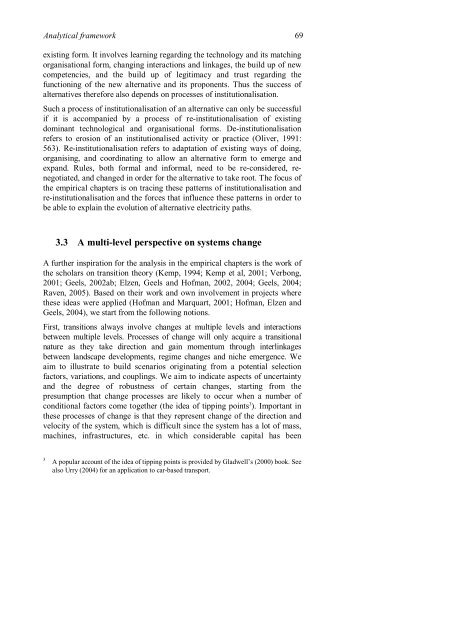Innovation and institutional change: the transition to a sustainable ...
Innovation and institutional change: the transition to a sustainable ...
Innovation and institutional change: the transition to a sustainable ...
You also want an ePaper? Increase the reach of your titles
YUMPU automatically turns print PDFs into web optimized ePapers that Google loves.
Analytical framework 69<br />
existing form. It involves learning regarding <strong>the</strong> technology <strong>and</strong> its matching<br />
organisational form, changing interactions <strong>and</strong> linkages, <strong>the</strong> build up of new<br />
competencies, <strong>and</strong> <strong>the</strong> build up of legitimacy <strong>and</strong> trust regarding <strong>the</strong><br />
functioning of <strong>the</strong> new alternative <strong>and</strong> its proponents. Thus <strong>the</strong> success of<br />
alternatives <strong>the</strong>refore also depends on processes of <strong>institutional</strong>isation.<br />
Such a process of <strong>institutional</strong>isation of an alternative can only be successful<br />
if it is accompanied by a process of re-<strong>institutional</strong>isation of existing<br />
dominant technological <strong>and</strong> organisational forms. De-<strong>institutional</strong>isation<br />
refers <strong>to</strong> erosion of an <strong>institutional</strong>ised activity or practice (Oliver, 1991:<br />
563). Re-<strong>institutional</strong>isation refers <strong>to</strong> adaptation of existing ways of doing,<br />
organising, <strong>and</strong> coordinating <strong>to</strong> allow an alternative form <strong>to</strong> emerge <strong>and</strong><br />
exp<strong>and</strong>. Rules, both formal <strong>and</strong> informal, need <strong>to</strong> be re-considered, renegotiated,<br />
<strong>and</strong> <strong>change</strong>d in order for <strong>the</strong> alternative <strong>to</strong> take root. The focus of<br />
<strong>the</strong> empirical chapters is on tracing <strong>the</strong>se patterns of <strong>institutional</strong>isation <strong>and</strong><br />
re-<strong>institutional</strong>isation <strong>and</strong> <strong>the</strong> forces that influence <strong>the</strong>se patterns in order <strong>to</strong><br />
be able <strong>to</strong> explain <strong>the</strong> evolution of alternative electricity paths.<br />
3.3 A multi-level perspective on systems <strong>change</strong><br />
A fur<strong>the</strong>r inspiration for <strong>the</strong> analysis in <strong>the</strong> empirical chapters is <strong>the</strong> work of<br />
<strong>the</strong> scholars on <strong>transition</strong> <strong>the</strong>ory (Kemp, 1994; Kemp et al, 2001; Verbong,<br />
2001; Geels, 2002ab; Elzen, Geels <strong>and</strong> Hofman, 2002, 2004; Geels, 2004;<br />
Raven, 2005). Based on <strong>the</strong>ir work <strong>and</strong> own involvement in projects where<br />
<strong>the</strong>se ideas were applied (Hofman <strong>and</strong> Marquart, 2001; Hofman, Elzen <strong>and</strong><br />
Geels, 2004), we start from <strong>the</strong> following notions.<br />
First, <strong>transition</strong>s always involve <strong>change</strong>s at multiple levels <strong>and</strong> interactions<br />
between multiple levels. Processes of <strong>change</strong> will only acquire a <strong>transition</strong>al<br />
nature as <strong>the</strong>y take direction <strong>and</strong> gain momentum through interlinkages<br />
between l<strong>and</strong>scape developments, regime <strong>change</strong>s <strong>and</strong> niche emergence. We<br />
aim <strong>to</strong> illustrate <strong>to</strong> build scenarios originating from a potential selection<br />
fac<strong>to</strong>rs, variations, <strong>and</strong> couplings. We aim <strong>to</strong> indicate aspects of uncertainty<br />
<strong>and</strong> <strong>the</strong> degree of robustness of certain <strong>change</strong>s, starting from <strong>the</strong><br />
presumption that <strong>change</strong> processes are likely <strong>to</strong> occur when a number of<br />
conditional fac<strong>to</strong>rs come <strong>to</strong>ge<strong>the</strong>r (<strong>the</strong> idea of tipping points 3 ). Important in<br />
<strong>the</strong>se processes of <strong>change</strong> is that <strong>the</strong>y represent <strong>change</strong> of <strong>the</strong> direction <strong>and</strong><br />
velocity of <strong>the</strong> system, which is difficult since <strong>the</strong> system has a lot of mass,<br />
machines, infrastructures, etc. in which considerable capital has been<br />
3 A popular account of <strong>the</strong> idea of tipping points is provided by Gladwell’s (2000) book. See<br />
also Urry (2004) for an application <strong>to</strong> car-based transport.
















